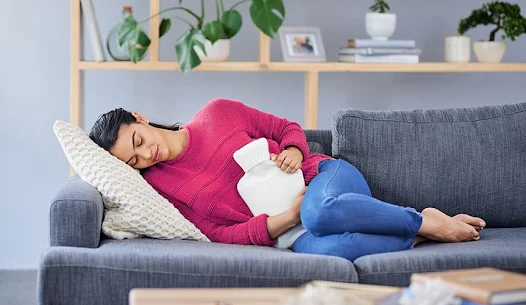Simple Cure For Menstrual Pain: How to treat period pains

It's usually felt as painful muscle cramps in the tummy, which can spread to the back and thighs.
The pain sometimes comes in intense spasms, while at other times it may be dull but more constant.
RELATED POST: How To Treat Menstrual Pains Naturally
It may also vary with each period. Some periods may cause little or no discomfort, while others may be more painful.
Sometimes you may get pelvic pain even when you do not have your period.
What causes period pain?
Period pain happens when the muscular wall of the womb tightens (contracts). Mild contractions continually occur in your womb, but they're usually so mild that most women cannot feel them.
During your period, the wall of the womb starts to contract more vigorously to help the womb lining shed as part of your period.
When the wall of the womb contracts, it compresses the blood vessels lining your womb. This temporarily cuts off the blood supply – and oxygen supply – to your womb. Without oxygen, the tissues in your womb release chemicals that trigger pain.
While your body is releasing these pain-triggering chemicals, it's also producing other chemicals called prostaglandins. These encourage the womb muscles to contract more, further increasing the level of pain.
It's not known why some women have more period pain than others. It may be that some women have a build-up of prostaglandins, which means they experience stronger contractions.
Period pain caused by a medical condition
Less commonly, period pain can be caused by an underlying medical condition.
Period pain linked to an underlying medical condition tends to affect older women. Women aged 30 to 45 are most commonly affected.
Medical conditions that can cause period pain include:
Endometriosis – where cells that normally line the womb grow in other places, such as in the fallopian tubes and ovaries; these cells can cause intense pain when they shed.
Fibroids – non-cancerous tumors that can grow in or around the womb and can make your periods heavy and painful pelvic inflammatory disease – where your womb, fallopian tubes and ovaries become infected with bacteria, causing them to become severely inflamed.
Adenomyosis – where the tissue that normally lines the womb starts to grow within the muscular womb wall, making your periods particularly painful.
Period pain caused by contraceptive devices
An intrauterine device (IUD) is a type of contraception made from copper and plastic that fits inside the womb. It can also sometimes cause period pain, particularly during the first few months after it's inserted.
You may notice a change in your normal pattern of pain if your period pain is linked to a medical condition or a contraceptive IUD. For example, the pain may be more severe or it may last much longer than normal.
You may also have:
- irregular periods
- bleeding in between periods
- a thick or foul-smelling vaginal discharge
- pain during s*x
How long will my period pain last?
Period pain usually starts when your bleeding begins, although some women have pain several days before the start of their period.
The pain usually lasts 48 to 72 hours, although it can last longer. It's usually at its worst when your bleeding is heaviest.
Young girls often have period pain when they begin getting periods. Read more about starting periods.
Period pain that does not have an underlying cause tends to improve as a woman gets older. Many women also notice an improvement after they've had children.
How can I treat period pain?
In most cases, period pain is mild enough to treat at home.Stop wasting your money on drugs because of menstrual pain.
Menstrual pain occurs when the blood is thickened which make it hard for its passage thereby giving you a stomach tumor or better still stomach imbalances because some nerves are connected directly from the uterus to the stomach.

Simple remedy for menstrual pain
1. Just take warm water to melt the thickened blood into a fluid form for easy passage or regular exercise few days before you experience your menstruation.
Applying
heat to your abdomen and lower back may relieve pain. A 2018
review of studies found that heat therapy (usually a
heat patch or pack) was as effective at treating menstrual pain as NSAIDS. It
also may cause fewer side effects. However, the authors noted that more
research is needed.
If you don’t have a hot water bottle or heating pad, take a
warm bath or use a hot towel. Or, you can make
your own heating pad:
Cut and sew together two pieces of fabric, leaving a hole at
the top.
Fill with uncooked rice and sew up the hole.
Microwave for a few minutes to the desired temperature.
Don’t overheat!
Let it cool, if necessary. Or, wrap your homemade pad in a
towel to reduce heat transfer. Apply on your lower abdomen while lying down. Reuse as necessary.
RELATED: Benefits of warm water



.jpg)







.jpeg)
